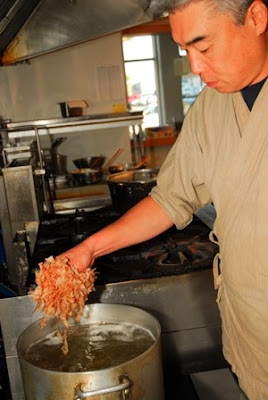
It all started one dark and rainy Monday night...Sanbiki was slow, slow, slow...what to do with our beautiful (and empty!) space? We have a great Sanbiki team from Kamloops, Japan and Korea....and yet they were spending another uneventful evening peeling carrots and polishing glasses. We kept our spirits up but we knew we could do better....
Enter Sanbiki's "Sushi School"....

Once a month we converted the far side of the restaurant into a "cooking classroom" where Masato and Kishino could pass along the secrets to rolling great sushi. For $40 and 2 hours, students learned how to prepare sushi rice and fillings. There was the opportunity to make and cut a variety of rolls and pick Masato's brains for ancient Japanese culinary secrets. Afterwards, everyone was free to eat the fruits of their labour or take them home for late night snacking.

Sushi school continues to draw new students and keeps us occupied on those chilly, uneventful Monday evenings. But getting a taste (literally!) for Japanese cooking at home seems to be catching on....sushi graduates started asking questions...complicated, non-sushi related questions that we could not adequately answer over the two hours alloted to our Monday sushi classes...
Enter Sanbiki's "Dashi School"....

More victims...I mean, "students"...for Master Masato and Mistress Kishino....


And what is dashi? Excellent question! Dashi is the most basic Japanese stock and the secret to making delicious miso soup, sunomono salad dressing and many other soups and sauces. Fresh is best but unused dashi can be frozen for later use too.

Dashi is made from katsuoboshi (dried tuna flakes) konbu (dried kelp) and niboshi (dried small silverfish, usually anchovies) Homemade dashi is wonderful; smoky, earthy and packed with "umami". "Umami" can be thought of as "yumminess"; a savoury flavourfulness that comes from the glutamates in the seaweed and fish. Other foods high in glutamates are mushrooms, truffles, soy sauce and interestingly, some cheeses; parmesan for example.

Almost everyone (restaurants included!) use instant powdered dashi. At Sanbiki we have always made our dashi from scratch. We are certain that this has helped us develop a "taste" that is different from our competitors and one which our customers appreciate.
During the dashi lesson, Masato tells students what and how they should taste the dashi. You can smell the ocean from the kelp and a slight smokiness from the dried fish. After making the dashi, Masato shows the class how to use it to make "Oyakodon" or "chicken and egg" rice bowl.

It can also be used in popular sunomono salads made from harusame (yam noodles), cucumber and shrimp or other garnishes.

And as a base for noodles in soup, hot pots or simmered dishes. We use our homemade dashi in Sanbiki's Tempura Udon. It's perfect cold weather comfort food and a customer favourite.

If you're interested in sushi or dashi making classes, please give us a call at the restaurant (377 8857) Suggestions for other cooking classes or menu ideas always welcome...call or send us an email!

Our new Build Your Own Bento dinner special is a hit!! Customers can choose from a variety of sushi rolls, appetizers (hot and cold!) and salads. Starting at only $10, we give you control...go on...Build A Bento tonight!!
Have a great week everyone! Sanbiki loves ya!

No comments:
Post a Comment